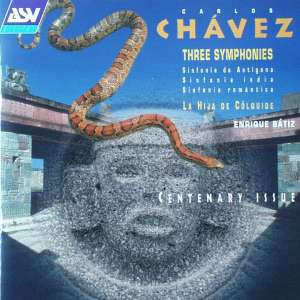|
An independent spirit
PATRIC STANDFORD considers a new Chavez CD
|


To listen to the aural illustrations in this review, you may need to download
RealNetworks' realplayer G2.
|
Carlos Chavez was 79 when he died on 2nd August 1978 at his home on the
outskirts of Mexico City. He had been born there, and apart from 8 months
in Paris as a kind of extended honeymoon after he married Otilia in 1922,
he was hardly ever away from his great home city.
He was a formidable pianist and spent most of his mature life as a conductor,
musical activist, educator and folklorist, but as a composer he was by far
the most important Latin American composer of his time. His music reflects
the power and determination of his personality. It is exotic and quirky,
partly because he was never enslaved by the European epidemic of what he
called 'the useless complications of German and French harmony treatises'.
His only composition teachers were 'the great masters', and he developed
an individual creative voice and a startling skill for orchestration, the
handling of instrumental colours and all kinds of percussion. This gives
the essential flavour to real Latin American symphonic music. It is there
in Ginastera and Villa-Lobos. It is something that sounds unbalanced, not
quite as it should, by those with a European ear-training. It is an independent
spirit, imitated as a sort of parody of the dilettante by Copland, Milhaud
and others, just as jazz had been imitated without understanding.
 But all this you can judge for yourself with this new CD of major orchestral
works by Carlos Chavez, conducted by his compatriot Enrique Bátiz,
the founder 30 years ago of the State of Mexico Symphony Orchestra. It is
a CD for those who do not know Chavez the composer - or those who only know
the exuberant Toccata for percussion and orchestra. Here there are three
of his seven symphonies, a symphonic suite culled from theatre music, and
a short, brilliant and perky 'symphonic painting' simply called Baile
(Dance). But all this you can judge for yourself with this new CD of major orchestral
works by Carlos Chavez, conducted by his compatriot Enrique Bátiz,
the founder 30 years ago of the State of Mexico Symphony Orchestra. It is
a CD for those who do not know Chavez the composer - or those who only know
the exuberant Toccata for percussion and orchestra. Here there are three
of his seven symphonies, a symphonic suite culled from theatre music, and
a short, brilliant and perky 'symphonic painting' simply called Baile
(Dance).
The symphonies 1, 2 and 4 cover twenty years from 1933, when Chavez wrote
music for Cocteau's adaptation of Sophocles and turned it into Sinfonía
de Antigona. Originally scored for an orchestra of wind and percussion,
it is, like so much of his music, justifiably described as 'austere', yet
richly colourful, haunting and mysterious. (Click
to listen.) The second symphony which, like the first, is in a single
short movement (both are under 14 minutes), may prove the most vigorously
attractive. Sinfonía india uses Indian themes, rhythmically
combining the primitive and the modern in an exciting sound world that includes
Yaqui drums, water gourds, clay rattles, butterfly cocoons and deer hooves.
(Click to listen.) The CD's centrepiece is its
longest, the five-movement suite La Hija de Cólquide (The
daughter of Colchis), a ballet written for Martha Graham in 1943 on the
Medea theme. This too is haunting, dwelling much on a solo oboe, but giving
prominence to the clarinet, trumpet and horn too, and allowing an overflow
of romantic diatonicism in a luxurious Peán, out of which
the clarinet and harp wander affectionately into the quiet spacious closing
Postludio.
The fourth symphony (Romántica) is in three terse movements,
with strong tonal allegiances, the last of which is a lively Latin dance.
The Baile of 1953 is the final piece in this concert and was originally
intended to be the fourth symphony's finale, but it stands on its own, a
brief escapade with an impudent piano part and short persistent rhythms
that bounce around energetically and remain in the memory. (Click
to listen.)
Enrique Bátiz conducts his own Mexican Symphony Orchestra (in
the substantial symphonic suite), the City of Mexico Philharmonic, and the
Royal Philharmonic with which he was principal guest conductor in 1984.
It is an excellent way of celebrating the centenary year of Carlos Chavez's
birth.
Copyright © Patric Standford, July
10th 1999
Carlos Chavez
Symphony No. 1 Sinfonía de Antigona (1933)
Royal Philharmonic Orchestra / Enrique Bátiz
Symphony No. 2 Sinfonía india (1935-6)
City of Mexico Philharmonic Orchestra / Enrique Bátiz
La Hija de Cólquide (The Daughter of Colchis) -
Symphonic suite (1943)
Claudia Coonce, oboe; State of Mexico Symphony Orchestra / Enrique Bátiz
Symphony No. 4 Sinfonia romántica (1953)
Royal Philharmonic Orchestra / Enrique Bátiz
Baile (Dance) - symphonic painting (1953)
State of Mexico Symphony Orchestra / Enrique Bátiz
ASV CD DCA 1058 77'10
ORDER THIS CD FROM CROTCHET |
<< Music & Vision
homepage More CD reviews >>
|